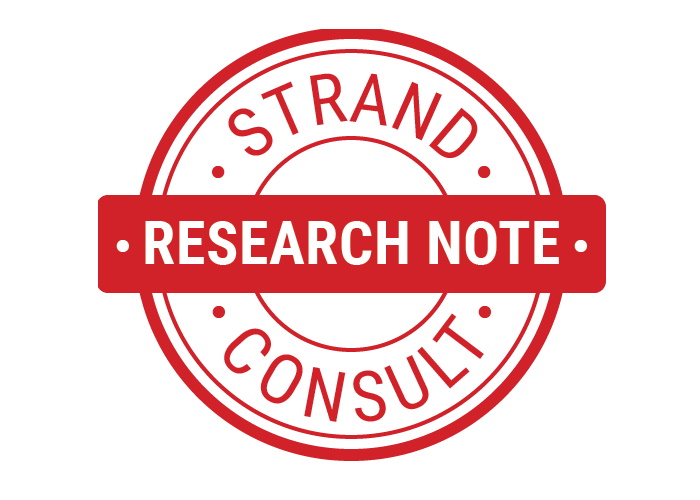Is telecoms consolidation in Asia, Africa, Latin American and Europe a challenge?

Many countries in Asia have a history of very competitive mobile markets and very low prices. This is immediately obvious on the streets of Bangkok, Hong Kong or Bangalore. Mobile data traffic per smartphone in South East Asia and Oceania is projected by the Ericsson Mobility Report to grow by 34% per year from 2021 to 2027 – well in access of the global average. Over half of all mobile subscribers are in the Asia-Pacific region and mobile networks are frequently used as the primary means of household internet access in the region.
As described in our report Understanding 4 to 3 mobile mergers mobile networks require high levels of sunk capital investment. New investment in a technologically volatile environment is inherently risky and costly as operators need to invest not only in equipment and backhaul networks but also in acquiring the spectrum required for efficient use of 5G infrastructure. Consolidation in mature markets has been ongoing: an initial 10 licensed operators for Hong Kong in 1996 had been reduced to 4 by 2014; in the USA the 4 major operators have been reduced to 3; Kenya has 3 operators left after Essar exited the market in 2014 and Brazil also has 3 national operators left after the weakest operator dropped out.
On 6 December 2021, the Financial Times reported South-east Asian telecoms merge into mega-groups to invest in 5G while hinting heavily that regulators should be less accommodating to consolidation in the sector. There are many reasons to believe this to be incorrect. First of all, even zealous regulators agree that there is no “magic number” that guarantees healthy competition in a market. Further, blocking mergers risks promoting static efficiency (prices) over dynamic efficiency (investment in product innovation and quality improvements) effects.
Thailand’s National Broadcasting and Telecommunications Commission has declared that it will not block a merger between True and Dtac (owned by Telenor) to form the new largest operator in the country. AIS (in which Singtel has a major stake) is likely to become the second operator with government owned National Telecom a very distant third. The merger between True and Dtac will combine True’s infrastructure and spectrum assets with Dtac’s customer base and cash but also add True’s subscription television and broadband customers. Thailand will go from 4 to 3 operators – only 2 of which private and large.
In Indonesia, the two largest operators are seeking approval for a merger in a market with 5 significant operators. Indosat Ooredoo and Hutchison 3 Indonesia will form the second largest operator, some distance behind Telkomsel. In our view this is a consolidation that should be particularly healthy for competition as it will create a strong second operator. The two companies have complementary infrastructure assets and products. There would be room in the market for further consolidation of the remaining small operators.
The Malaysian Communications and Multimedia Commission has received an application to merge from local firm Celcom Axiata and Digi.Com (in which Telenor is a major shareholder). The merged firm would have a market share of around 45%. It would leave Maxis as the second largest operator with over 20% of market share with small operators dividing up the rest. During the pandemic period, Malaysian users’ mobile data use showed exceptionally fast growth and operators will probably need to consolidate in order to invest in 4G and 5G coverage and upgrades.
In Australia, Vodafone and TPG completed a merger in 2020 that reduced the number of mobile operators from 4 to 3. The regulator had announced in 2019 that it would oppose the proposed consolidation but Australian Federal Court overturned the decision almost immediately, saying it was “commercially rational for Vodafone and TPG to merge, with the result that both companies will be enhanced and will be a stronger force against Telstra and Optus” (the two largest mobile operators). This was a solid and correct decision that is discussed in our report Understanding 4 to 3 mobile mergers along with other cases.
Consolidation in the mobile industry is taking place throughout the world. In South Africa the de facto industry structure has been molded by spectrum holdings and sharing arrangements with the number of mobile operators effectively reduced to three. O2 and Virgin merged in the UK in 2020 in the biggest merger of the decade. The merger of Sprint and T-mobile in the USA in 2020 after a two-year approval process is of course the prime example. The historical facts show that the T-Mobile/Sprint merger is good news for competition, innovation and infrastructure investment in the USA. Also see our research not on what people are missing when they evaluate this merger.
Unfortunately, regulators have sometimes stood in the way of good mergers, e.g. Hutchison/O2 in the UK where the European General Court annulled the European Commission decision. In this case leaked documents show how authorities misunderstood the market. Decisions have run into the hundreds of pages, including complex analyses of data that serve as a proxy for parameters in a model which the regulators hope will compute a direction in which prices might move (compared to the unobserved counterfactual). This can produce very weak evidence that prices might have declined more in markets without mergers but prices inevitably continue to decline anyway.
Operators, on the other hand, often exaggerate the benefits of a merger in anticipation of regulators zealous scrutiny of their motives. This is a mistake but an understandable one as regulators often use inappropriate analytical models to assess possible deals. One of the dangers of doing so is that the authorities will require a remedy which is in fact uneconomic even though it appears to be affordable in the analysis presented by the merging parties.
Regardless of the putative number of operators in a given jurisdiction (for example, determined by the number of licensed operators), considerable asset sharing is occurring in passive network elements. In most jurisdictions (including Asia), passive infrastructure such as towers is arguably more closely-held than network operators. Specialist tower owning firms (such as Tower Xchange) have a strong presence in Asia, with the operators that lease space on them typically having non-trivial shareholdings in the tower companies. This reflects a natural tendency towards asset-sharing to spread the large fixed costs associated with nationwide wide coverage across a number of operator firms. To date, there has been little antitrust interest in the extent to which network operators are potentially collaborating via a mix of contract and vertical integration, despite the risk of tower access pricing (an essential component of mobile network supply) showing market power characteristics.
Equally, active infrastructure can also be shared by way of roaming agreements between operators within a single national boundary. These arrangements can be utilized to overcome restrictions in spectrum availability (e.g. South Africa) or as a means of further spreading the high fixed costs of spectrum acquisition across operators, particularly in low-income countries. Both passive and active asset sharing are likely to become more prevalent as 5G networks are rolled out, especially as these new networks will initially be complementary to rather than replacements for existing 4G/LTE investments. Indeed, the ITU in its 2019 recommendations for the Asia-Pacific region urged greater use of asset sharing to speed up 5G deployment.
Considering the historical evidence in several jurisdictions regarding mobile carrier mergers that were (1) approved; (2) approved with undertakings or (not approved) our report Understanding 4 to 3 mobile mergers has documented the harm done by prohibiting mergers in the frequency with which remedies imposed are ineffective. The many court cases which have challenged antitrust authorities’ resistance to mergers in Australia and the EU supports the need for regulators to adopt a more informed approach which takes into account a range of competitive factors, not just price and the number of firms in the market.
Mobile industry mergers that reduce the number of national operators have been subject to particular scrutiny by regulators, politicians and even by the public. The bottom line is that across the world there have bean lots of consolidation and despite that traffic have gone up and prices have gone down. Strand Consult has conducted research into both specific cases across the world and the general principles around mergers of mobile operators over the past two decades. The Understanding 4 to 3 mobile mergers report combines insights of high-level academic research with the expertise on telecommunications industry dynamics for which Strand Consult is known. It also includes an extensive review of specific cases, including an analysis of the aftermath of decision made by regulators.
The purpose of the report Understanding 4 to 3 mobile mergers is to help operators save time and money. Most mobile industry CEOs have never presided over a 4 to 3 mobile merger; this report can fast-track the knowledge. It provides theoretical, practical, and legal perspectives to put 4 to 3 mobile mergers in context and offers an extensive resource of authoritative information on the topic.
Mobile operators need to be smarter in their consolidation strategies; antitrust authorities need to improve their toolsets and measurement techniques; and policymakers need to modernize the standard of review. This report reveals what needs to be done to consolidate the mobile industry in markets around the world.
To find out more and review the table of contents, contact Strand Consult.
